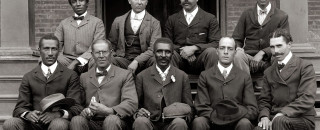The History of Science Isn't the Same Without Black History
George Washington Carver, bottom center, with faculty of the Tuskegee Institute. Credit: Library of Congress
By Riley Black
Perhaps you're familiar with the name George Washington Carver. Born in 1864, Carver grew up to be a pioneering agriculturalist and inventor, the first Black person in the United States to earn a Bachelor of Science degree and an advocate for farming techniques like crop rotation to help poor farmers become self-sufficient. He took what he had learned about plants, soils, and how they interact to help others, promoting crops like peanuts as alternatives to repeated plantings of cotton. His work changed his scientific field as well as the literal fields of farmers.
Many of us learn about Carver and his acheivements in elementary school during Black History Month. That's a good thing, but it's also not enough. As science struggles to change, diversify, and become more equitable, it is often easy for a handful of scientific figures to be highlighted as pioneers with little discussion of the hardships they faced or how discrimination still exists in our 21st century society. The history of science is entwined with Black history, including both remarkable success stories such as Carver's as well as the legacies of racism that still affect science.
Consider what stories we often highlight in the sciences and where we focus our attention. Museums and scientists all over the world recently celebrated the academic achievements of Charles Darwin, the 19th century Englishman who co-discovered evolution by natural selection with Alfred Russel Wallace. But do you know who taught a young Darwin the art of taxidermy that the naturalist-to-be would use during his voyage on the Beagle? That was John Edmonstone, a Black man from Guyana who had been enslaved, freed, and learned his craft before his time in Edinburgh. Edmonstone passed his skills on to Darwin, but it has only been in recent years that historians have tried to understand more about his life. The systemic racism of the time blocked Edmonstone from many of the priveleges the wealthy and well-connected Darwin enjoyed.
Black people have overcome incredible barriers to engage in science, and still do, but it's also important to recognize that science helped to put those barriers there in the first place. As the science of anthropology became established in the United States in the 19th century, for example, many early anthropologists were focused on what they believed were racial differences between people and created discriminatory, ranked classifications that influenced politics and policy. Medical science, as well, has a long history of discrimination and predatory behavior against Black people - like when the cervical cancer cells of Henrietta Lacks were taken without her knowledge or consent in 1951. Lack's cells fascinated researchers and have been used in a vast amount of medical research, yet the researchers and corporations that have profited from Lacks' stolen cells did not compensate her family.
The history of science can't be understood without Black history. These stories - of both hardship and success - are important to remember, especially when they make us question what we've always taken as true. Looking to the past can help us better visualize how we want to be different and what steps we can take to stop and correct against injustice. As Vanderbilt University neuroscientist Kellie Williford put it, “Black History Month is not only about celebrating our roots as Black people, but also lifting each other up in the here and now, and making sure things are better for those coming after us."
Riley Black is the author of The Last Days of the Dinosaurs, Skeleton Keys, My Beloved Brontosaurus, and is a science writer for the Natural History Museum of Utah, a part of the University of Utah in Salt Lake City. Our mission is to illiminate the natural world and the place of humans within it. In addition to housing outstanding exhibits for the public, NHMU is a research museum. Learn more.



